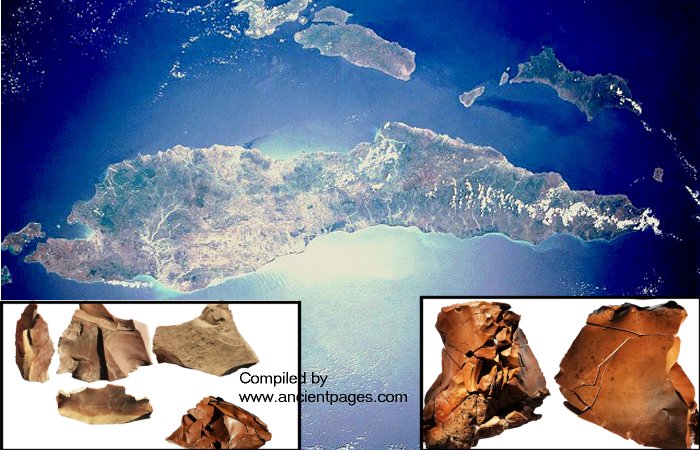Jan Bartek - AncientPages.com - The recent discovery of thousands of stone artifacts and animal bones in a deep cave on Timor Island has prompted archaeologists to reevaluate the route early humans took to reach Australia.
Scientists have meticulously dated and analyzed the artifacts and sediment found at the Laili rock shelter in central-north Timor-Leste, located north of Australia, to pinpoint the arrival of these ancient colonists. Their findings revealed a distinct human "arrival signature" dating back approximately 44,000 years ago, indicating that the island was uninhabited by humans before this period. This groundbreaking evidence sheds new light on the migratory patterns and timeline of early human expansion into the region.
Timor Island as seen from space. Credit: NASA - Public Domain
"Unlike other sites in the region, the Laili rock shelter preserved deep sediments dating between 59,000 and 54,000 years ago which showed no clear signs of human occupation,"
When we analyze and compare markers of human occupation from other sites across Timor-Leste and nearby Flores Island, we can confidently say humans were also absent throughout the broader region of the southern Wallacean islands. This is significant as these islands were most likely a gateway for ancient humans to cross to Australia," said Dr. Shimona Kealy from the Australian National University (ANU).
According to study co-author Professor Sue O'Connor from the Australian National University, Timor Island has long been regarded as a stepping stone for the first human migration from mainland Southeast Asia to Australia and New Guinea. However, the new findings from this study challenge this long-held theory, potentially reshaping our understanding of the initial human settlement patterns in the region.
"The absence of humans on Timor Island earlier than at least 50,000 years ago is significant as it indicates that these early humans arrived on the island later than previously believed," she said.
"This provides further evidence to suggest early humans were making the crossing to Australia using the stepping stone island of New Guinea, rather than Timor Island as researchers had previously suggested. In addition to prompting a re-evaluation of the route and timing of earliest human migration through Wallacea and into Sahul, our findings highlight the fact that migration into the islands was ongoing with occupation of the southern islands occurring thousands of years after the initial settlement of Australia."
The shift from pre-occupation to intensive human activity at the site was very clear in the sediments," explained Associate Professor Morley from Flinders University, who analyzed the sediment from the site.
The research team uncovered numerous small stone tools and charred fish bones during the excavation. These findings provide valuable insights into the site's ancient inhabitants' daily activities and dietary habits.
A hierarchical disc core that was subsequently used as a multiple-notch tool. Below, refitted flake large flake from Laili Layer 20 that was reduced into at least 70 smaller flakes with some of these used as tools. Credit: Nature Communications
"We know these people specialized in making tiny stone tools, but we're not 100 percent sure what they were used for," Dr. Kealy said. "Because a lot of their diet was either shellfish or small animals, you don't really need big knives to gather that sort of food. But having small, fine tools is useful for things like stripping leaves to then weave into baskets, but also for creating wooden tools."
The archaeological findings at the site suggest that the migration to Timor Island was a significant event. The researchers assert that the substantial number of artifacts uncovered indicates a "major" migration. According to their analysis, these ancient humans likely journeyed to Timor from the nearby Flores Island and mainland Southeast Asia. The evidence points to a substantial movement of people to the island during that period.
"The traditional view held by researchers is that early humans who were making these significant water crossings were stumbling upon these islands by mistake, largely because it was so long ago," Dr. Kealy noted.
See also: More Archaeology News
"Their arrival on Timor was no accident. This was a major colonization effort, evident through the sheer number of people who were making the journey. It's a testament to these peoples' level of maritime technology and the boats they created, but also their confidence and competence in braving maritime crossings."
The study was published in the journal Nature Communications
Written by Jan Bartek - AncientPages.com Staff Writer
